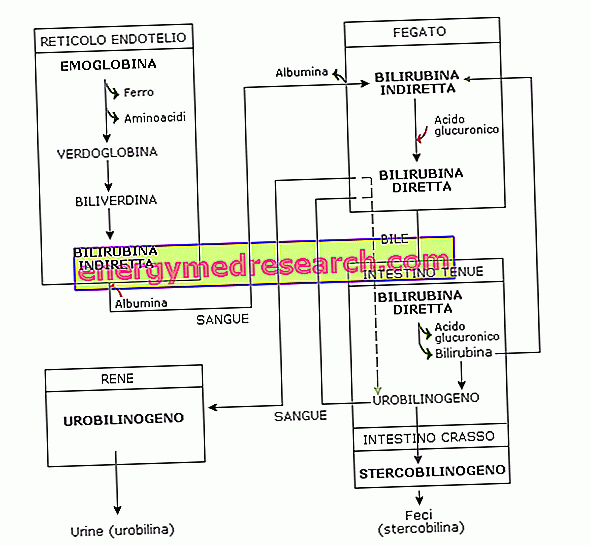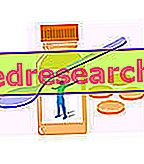See also: high blood and bilirubin analysis
Generality
Bilirubin is a substance that derives from the degradation of hemoglobin, more particularly from the conversion of the EME prosthetic group contained in it.
- Most bilirubin (85%) derives from the normal process of destruction of exhausted red blood cells. These cells have a life of about 120 days: first they are degraded by the spleen and are incorporated into the biliverdin, then the residues are transported to the liver to be metabolized.
- The remaining part of the bilirubin comes, instead, from the bone marrow or from the liver.
Under normal conditions, all the bilirubin that originates from hemoglobin is eliminated by a mechanism that is usually in equilibrium: what is produced, is also processed to be degraded. However, if we notice a yellowish complexion of the skin and eyes, we find ourselves facing a clinical condition - caused by high circulating bilirubin - called jaundice .
The bilirubin test measures its concentration in the blood to assess liver function or to diagnose anemia caused by damage or degradation of red blood cells (haemolytic anemia) .
What are
BILIRUBINE is a yellow-orange bile pigment, a waste metabolite deriving from the catabolism of aged red blood cells .
Eitrocytes (red blood cells) live on average 110-130 days, after which they can go against spontaneous rupture while they try to pass into the capillaries or be intercepted by macrophages of the spleen. In both cases, the body cannot afford the luxury of wasting some of their constituents, first of all the iron contained in the EME prosthetic group (which represents the oxygen-binding heart of hemoglobin).
The recycling operations take place mainly at the level of the spleen, where the waste molecules are incorporated in a green color pigment, called BILIVERDINA, readily converted into bilirubin .
The bilirubin, yellow-orange in color and not reusable, must be eliminated; to do this, the organism must first make it acquire water solubility; for this reason it is transported in the blood stream by a specific carrier, in this case albumin.
Plasma albumin carries bilirubin up to the liver, which helps to make it water-soluble, combining it with glucoronic acid and transforming it into bilirubin diglucuronide, also known as direct bilirubin or conjugated bilirubin . We speak instead of indirect bilirubin to indicate the proportion of bilirubin that must still be processed by the liver.

Unconjugated bilirubin, not being water-soluble, cannot be filtered by the kidney, so it is not found in urine. However, due to its high liposolubility, once removed from albumin, it can easily penetrate into tissues.
The relationship between direct bilirubin and indirect bilirubin, which varies on average between 1: 4 and 1: 5, is a very important, and therefore widely used, diagnostic criterion for assessing liver function .
The daily proportion of total bilirubin (deriving from the sum of these two fractions) is around 250 mg and reaches an average concentration of 1-1.5 mg / dL in the blood.
The block or deficiency of the mechanisms of excretion of bilirubin leads to its accumulation in the blood ( hyperbilirubinemia ) and in the tissues, inducing a condition, known as jaundice, in which the skin is yellowish.
Metabolism and excretion of bilirubin
The direct bilirubin produced by the liver is conveyed into the bile and, after a brief stay inside the gall bladder, is poured into the small intestine. Here, particular enzymes, called B-glucoronidases, operate a reverse process to the hepatic one, detaching the glucoronic acid from the direct bilirubin.
The simple bilirubin thus obtained is readily metabolized by the intestinal microbial flora, reducing to urobilinogen. A small proportion of this urobilinogen is reabsorbed by the intestine, so it is mostly conveyed to the liver which will provide to transfer it into the intestine through the bile; another small percentage is instead oxidized and eliminated, in the form of urobilin, with the urine, to which it gives the typical straw tones.
A good part of the urobilinogen produced at the enteric level reaches the large intestine, where it undergoes a further attack by the microbial flora, turning into stercobilinogen, which is eliminated as such through the faeces.
The proportion of simple bilirubin that escapes the metabolism of the intestinal bacterial flora is reabsorbed and transported directly to the liver which, as a tireless worker, conjugates it again with glucoronic acid, then pouring it into the bile. If for some reason, for example due to an antibiotic therapy, the intestinal microbial flora decreases, there will be less conversion of simple bilirubin into urobilinogen. As a result the enteropathic circulation of bile pigments will be enhanced and the blood will contain a greater percentage of bilirubin.

- About 80-90% of the bilirubin produced daily originates from the catabolism of hemoglobin, while the remaining percentage derives from the lysis of the other hemoproteins (myoglobin, cytochromes, peroxidase, catalase) and erythroblasts (due to anomalies that occur during the synthesis of red blood cells in the bone marrow, see ineffective erythropoiesis).
- Bilirubin is formed mainly in the spleen, but also in other tissues, particularly in the bone marrow, lymph nodes and liver.
- The transformation of EME into bilirubin is responsible for the gradual color change, from purple to yellow, which occurs in hematomas.
Because they measure themselves
Blood levels of direct and total bilirubin are detected with a simple blood test; alternatively the test can also be conducted on urine.
Indirect bilirubin concentrations are obtained by difference, subtracting from the total value the conjugate form.
Bilirubin examination is useful in the following cases:
- Check liver function;
- Diagnosing and / or monitoring diseases of the liver and bile ducts (eg cirrhosis, hepatitis or calculi);
- Monitor neonatal jaundice;
- Check patients suffering from sickle cell anemia or other causes of haemolytic anemia, which may have episodes called "crises" in which there is excessive destruction of erythrocytes, with an increase in bilirubin.
Diagnostic role of biliverdin
Biliverdin may be found in excess in the blood of people with liver disease .
In these cases, jaundice is caused by the accumulation of biliverdin, bilirubin or both in the circulatory system and in the tissues.
Normal values
In adults, bilirubin values are generally very low, if we consider that the mechanism by which it is metabolized is always in balance with that of production.
Total bilirubin | 0.3-1.0 mg / dL or 5.1-17.0 mmol / L |
Direct bilirubin | 0.1-0.3 mg / dL or 1.7-5.1 mmol / L |
Indirect bilirubin (total bilirubin - direct bilirubin) | 0.2-0.8 mg / dL or 3.4-12.0 mmol / L |
Note : the reference values may change according to age, sex and instrumentation used in the analysis laboratory. For this reason, it is preferable to consult the ranges listed directly on the report. It should also be remembered that the results of the analyzes must be assessed as a whole by the general practitioner who knows the patient's medical history.
High Bilirubin - Causes
- An increase in indirect bilirubin in the blood may be the result of excess production (as in the case of hemolytic diseases) or a defect in liver activity (eg cirrhosis). An increase in the indirect quota can generate anxiety in the person concerned; sometimes, however, this increase may be an effect of Gilbert's syndrome, a relatively benign condition of genetic origin, relatively frequent, due to a delay by the liver in capturing the circulating indirect bilirubin.
- An increase in direct bilirubin may depend on biliary stasis due to hepatitis, cirrhosis or obstruction of the biliary tract due to the presence of stones or pancreatic diseases. This phenomenon may also depend on reactions to drugs and disorders caused by alcohol abuse.
- Rare hereditary diseases are responsible for an abnormal metabolism of bilirubin, such as the syndromes of Rotor, Dubin-Johnson and Crigler-Najjar; these can cause an increased concentration of the parameter.
Low Bilirubin - Causes
Low levels of bilirubin are usually not dangerous and are not monitored.
How to measure them
To assess the amount of bilirubin, a blood sample taken from a vein in the arm is needed.
Preparation
During the exam preparation, the patient is invited to fast in the four hours preceding the test.
The doctor can also impose the suspension of certain drug therapies, in order to avoid possible interference with the results of the examination.
Interpretation of Results
The set of bilirubin test results can provide the clinician with information regarding the present disease.
For example, unconjugated bilirubin can become high when the liver is unable to process it (in liver diseases such as cirrhosis or in hereditary diseases) or following an increased destruction of red blood cells (hemolysis).
Conjugated bilirubin can increase, however, when the liver is able to metabolize the substance, but is unable to transport it to the intestine, so that it is removed; in this case, the reason is usually attributable to acute hepatitis or bile duct obstruction.



